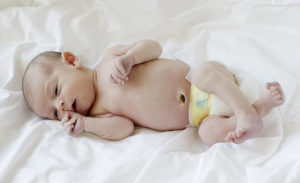Taking care of a baby can be a real challenge, especially for first-time mothers and fathers, who lack experience. There are so many elements and points to consider that sometimes we forget certain details.
There are certain details about hygiene, like how to care for your baby’s belly button, for example, that are very important, especially in the first days of life but often end up going unnoticed by some parents. And if you still don’t know the best way to carry out this cleaning, that’s what we’ll talk about in today’s article.
Why Is It So Important to Care for the Baby’s Belly Button?
The belly button is the main source of connection between a mother and her baby when the baby is still inside her1. That’s where the umbilical cord comes from, carrying all the nutrients the baby needs to develop during those 9 months. At the time of delivery, the cord is cut, but a small part of it, 2 to 3 cm long, called the umbilical stump, still remains on the baby’s belly button.
Within the first 20 days of the baby’s life, the stump turns black and falls off, leaving behind a small wound that takes about a week to heal, although the process can take a little longer than 30 days if there is a slight delay in the stump falling off and healing.
So, we can conclude that the reason caring for the baby’s belly button is so important is because this is usually the first wound of their life, at a stage when they are still extremely fragile. Taking the necessary steps to ensure this wound heals properly helps keep your baby free from related problems2.
Step-by-Step Guide for Caring for the Baby’s Belly Button
The process of caring for your baby’s belly button can be divided into a few stages:
- With the Stump
- After the Stump Falls Off
- Cases of Inflammation
Each of these stages requires a specific type of cleaning, so we will discuss each one separately.
With the Stump
Cleaning the baby’s belly button should begin during the first days of life, using cotton swabs and 70% alcohol. The cleaning should be done about three times a day, and it is recommended that you let the belly button air dry. It is also important to emphasize that alcohol does not hurt the baby in any way, although the baby might cry because of the cold sensation of the liquid.
After the Stump Falls Off
After the stump falls off and a wound is left at the baby’s belly button, you should continue to clean the area in the same way, but pay extra attention to make sure the open wound does not become infected. Healing normally occurs within seven to ten days, but there’s no need to worry if it takes a little longer.
Cases of Inflammation
In some cases, the baby’s belly button becomes inflamed. You can notice this by the presence of discharge from the wound, redness, and swelling. If this happens, you should take your baby to a pediatrician.
When Should You See a Doctor?
In addition to cases where the baby’s belly button is inflamed, there are other situations when you should see a doctor, for example, when healing takes a lot longer than normal. In such cases, the doctor will check to see if the baby has any underlying issues and may recommend an ointment to speed up the process.
It’s important that you never use any ointment or medication before speaking with a doctor, precisely because the doctor may explain that the wound is healing, just more slowly, and that no further action is needed. Don’t panic—it’s very common for some babies to take a bit longer than others in various aspects of life.
Umbilical Hernia
An umbilical hernia occurs when, after the stump falls off, the baby’s belly button still has a small bulge. In some cases, another condition called a protruding belly button is identified, but more commonly, it is an umbilical hernia3.
This condition can cause some discomfort for the baby, leading to pain, difficulty passing stools, and problems that result from these difficulties. However, the most common scenario is that the hernia disappears on its own in about 6 months, though it may take more or less time depending on the baby.
If it does not go away by itself, sometimes surgery may be necessary to remove it, but this is something to be discussed in detail with your pediatrician.
When a mother asks how to care for her baby’s belly button, it doesn’t mean she doesn’t know how to look after her child or doesn’t care about their hygiene—quite the opposite. It’s normal for us not to know every detail about motherhood, but what’s important is to research, seek answers, know that there are reliable sources, see a doctor when needed, and gradually understand each aspect.
As we mentioned at the beginning of the article, having a baby opens up a whole new world to us and forces us to learn more and more about things we didn’t even realize existed. This is undoubtedly one of the positives of parenthood: learning with your child every moment.












